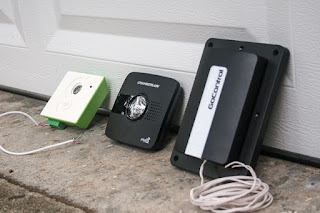Twane Turnage and Anthony Garner stood at the bottom of a bright orange ladder and carefully guided a solar panel (for example:
GOAL ZERO NOMAD 7 ) with hooks and ropes attached along the ladder rails toward a pitched roof.
“Pull!” hollered Turnage, 18.
“Pull!” echoed Garner, 21.
Above them, their
colleagues peered over the edge of the roof, pulling the rope on the rudimentary pulley system to haul the panel up while the ladder kept it from banging against the wall.
Over the next two hours, the team would repeat this process 20 times to transport all 20 solar panels onto the roof.
Turnage and Garner were two of five trainees who recently installed
solar panels at the Woodland home of retiree Catherine Bennett, 78.
“I knew I needed a little help” with the
electricity bill, said Bennett, who has lived in the house in Southeast Washington for 41 years. “This may help me some.”
Decked out in green hard hats, yellow T-shirts, and harnesses, the trainees were supervised by members of GRID Alternatives Mid-Atlantic, the regional branch of a national nonprofit group that helps implement
solar power for low- to moderate-income families free.
The trainees are part of the summer cohort of the newly launched Solar Works DC, a low-income
solar installation and job-training program jointly developed by the District’s Department of Energy and Environment and the Department of Employment Services. The program will train more than 200 D.C. residents over three years, and GRID Alternatives Mid-Atlantic was awarded a grant to implement the first year of the program. The organization will train about 75 program participants in skills needed for careers in solar and related fields, and
install solar panels for 60 to 100 income-qualified District homeowners.
Before homeowners can receive their solar panels, a shade analysis is conducted to make sure the panels will receive sufficient sunlight to make the system viable. Once the panels are installed, any solar energy that is not needed to power the house is transferred to the power grid.
Equitable solar
All of this is part of the District’s larger goal of having 50 percent of its
energy supply come from renewable sources by 2032, of which 5 percent would come from local solar power, as outlined in the city’s climate and energy plan. And training young residents in solar installation would prepare them to work in the rapidly growing solar industry, which added jobs almost 17 times as fast as the overall U.S. economy last year, according to an International
Renewable Energy Agency report.
But installing solar panels isn’t cheap, and for many, shelling out thousands of dollars upfront simply isn’t affordable. There is a risk of exacerbating the city’s economic divide: Wealthier households that can finance
solar installations could end up reaping the benefits of energy savings, while poorer households continue to be disproportionately burdened by utility bills.
The District is well aware of the inequality of solar power access and is working to remedy that by targeting poorer households as it seeks to expand the amount of solar energy generated locally. The goal is to help 100,000 low-income households reduce their electricity bills by at least half through solar energy.
Equity “needs to be at the forefront of the renewable energy economy,” said Nicole Steele, executive director of GRID Alternatives Mid-Atlantic. Unless renewable energy is equally and widely accessible, people will continue to rely on fossil fuels, and the utilities industry will remain stuck in its current model, she said.
“Every little bit . . . helps”
“Rope!” said Dexter Rawlings, 24, a Solar Works trainee, as he tossed the rope from the roof back down to the ground, ready to be hooked to the next solar panel.
Next to him stood another trainee, Whitney Jackson, 23, who only weeks before was too afraid of heights to even fathom spending hours working on a roof. Now, she moved about confidently, maneuvering the panels and attaching them to the mounting racks, which they had installed the day before.
The learning curve has been steep, she said, but the work has been “challenging and rewarding at the same time, because you know you’re making a difference in homeowners’ lives.”
Harold Thomas, 76, is one such homeowner.
GRID Alternatives Mid-Atlantic installed solar panels on the roof of his home in Congress Heights at no cost to him two years ago. Since then, he has made “noticeable” savings, Thomas said.
His house was the first in the neighborhood to go solar, said Thomas, who lives and works as a community advocate in Henson Ridge, a townhouse development built on the site of two demolished public housing complexes.
“$13, $3.33, $33 . . .” Thomas said, listing out his substantially lower electricity bills. In his pre-solar days, the bills were about $100 a month.
There have even been a handful of months when his bill came out to zero, he said.
Those savings have added up, and they have gone toward “buying more food, buying more clothes, and paying more bills,” Thomas said.
Solar panels have also helped ease financial burdens for Kirby York, 30. She and her husband purchased their home near the Congress Heights Metro station in 2014, but within months she had both given birth to a child and lost her job.









